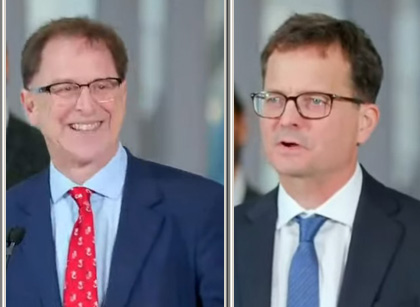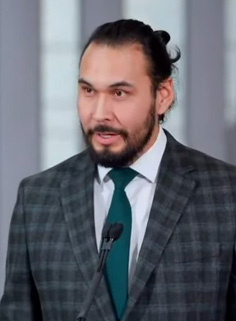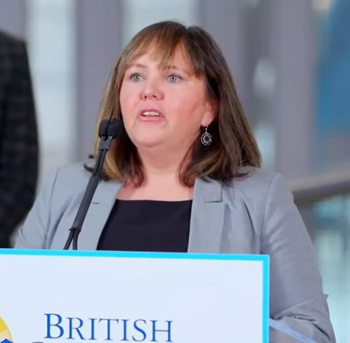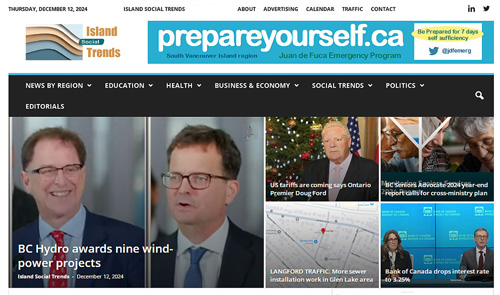
Thursday December 12, 2024 | VICTORIA, BC
by Mary P Brooke | Island Social Trends
Nine new wind projects will be built faster and boost the electricity supply in BC. A call for power earlier this year had received 21 applications.
This will make BC into a “a clean-energy superpower, while ensuring rates are affordable for people and businesses”, said Energy and Climate Solutions Minister Adrian Dix this week in a media announcement on Monday December 9.

Electricity demand in BC is expected to increase by 15% or more between now and 2030 as society and economy rely even more on technology and convenience. It could be said that ‘small is the new normal’ — the new projects will boost capacity by 8% at relatively less cost than building a massive hydroelectric dam facility which will contribute about the same amount of electricity.
The wind does always blow; hydroelectric is a reliable backup. The government was open to a range of energy-source types of projects. Eby said the wind power projects ended up being the most cost-effective for taxpayers.
The technology exists, i’s cost effective, and the projects can get rolling now, compared to nuclear which is more costly, perhaps more dangerous due to requiring waste product storage, said Premier David Eby on Monday.

One project on Vancouver Island:
Of the nine projects, one is on Vancouver Island; the others are in the Interior and northern BC.
The Brewster Wind Project on Vancouver Island is by Brewster Wind Inc with two partners: IPP partner Capstone Infrastructure and First Nation partner Wei Wai Kum First Nation.
The project size is 197 MW within the Vancouver Island regional system.
Less costly:
The overall cost of the new wind power approach will cost 40% less than the call for power that was done in 2010 under the BC Liberal government.
“This is urgent action on climate change,” said Dix on Monday. “It’s important that these projects get built, and built quickly,” said Dix.
Clean, affordable electricity will serve BC’s growing communities and housing needs, as people and businesses choose clean energy in their lives, homes, vehicles and businesses.
“Clean and affordable electricity is key to powering economic growth and unlocking private-sector investment that creates thousands of good jobs here in British Columbia,” said Premier David Eby.
“These new projects will significantly expand our electricity supply – making B.C. a clean-energy superpower, while ensuring rates are affordable for people and for industries looking to expand,” said Eby in a news release this week.
Eby said the new projects “take pressure off of rates”.
There is an investment of $4 billion to $6 billion from the private sector in these projects, said Eby, calling that “a massive win for British Columbians” including job creation.
Rates would go up quite dramatically if this infrastructure is not built now, said Eby.
“Opportunity is there as long as generation is there,” said Eby regarding businesses needing more electricity for expansion.
Strong response:
BC Hydro received a strong response to its call for new renewable power-generation projects, and through its evaluation process will award 30-year electricity purchase agreements to nine wind projects. These projects will provide nearly 5,000 gigawatt hours per year of electricity, enough to power 500,000 new homes, boosting BC Hydro’s current supply by 8%.
The development and construction of new clean-energy projects, in response to the call for power, will generate between $5 billion and $6 billion in private capital spending throughout the province.
“We need these new energy generation projects urgently to meet growing demand for power and accelerate our efforts to build a prosperous and inclusive clean economy,” said Adrian Dix, Minister of Energy and Climate Solutions. “Now that the projects have been selected, we’re going to work together with BC Hydro, First Nations and proponents to get these projects built quickly, responsibly and efficiently, and get those turbines spinning.”
To ensure the projects are completed as efficiently as possible, the Province intends to exempt these wind projects and all future wind projects in B.C. from environmental assessment, while ensuring First Nations interests and environmental mitigations are protected and maintained.
Wind-power exempt from environmental assessment:
“It’s clear there are enormous opportunities to generate clean electricity through wind, and that we need to do more to get larger projects online faster,” said Tamara Davidson, Minister of Environment and Parks.
“That’s why we are announcing our intention to exempt wind-power projects from the environmental assessment process, with a rigorous provincial permitting process in place, while ensuring First Nations are full partners in our shared, sustainable future.”
First Nations buy-in:
BC Hydro engaged extensively with First Nations on the design of the call for power, and included a requirement that projects must have a minimum 25% equity ownership held by First Nations.

Eight of the nine successful energy projects will have 51% equity ownership, says the BC Government. This represents $2.5 billion to $3 billion of ownership by First Nations in new renewable energy projects in the province.
Costs have decreased:
The cost of wind has dropped significantly over the past decade, and these new projects align with the trend of renewable costs decreasing. When adjusted to today’s dollars, the average price from the successful projects in this call is about 40% lower than BC Hydro’s last call for clean power in 2010, reducing rate impacts and keeping electricity bills affordable for people and businesses.
Adding these new wind projects will diversify BC Hydro’s generation mix. B.C. is well positioned to add more intermittent renewables, such as wind, to the electricity grid as its integrated, flexible system of hydroelectric dams act as batteries. Reservoirs store water and allow BC Hydro to ramp production up or down almost instantly, providing a reliable backup when the wind is not blowing.
More calls to power to come:
The Province and BC Hydro are committed to conducting regular, competitive calls for power based on electricity demand. This will ensure that B.C. has the clean electricity it needs as the economy and population continues to grow, while keeping BC Hydro rates affordable.
BC Hydro President Chris O’Reilly said this week that the next call for power will probably happen within the next two years.
Populations growth, construction, industry:
Along with the call for power, BC Hydro is taking a number of actions to ensure it will continue to meet the growing demand from population growth and housing construction, business and industrial development, and transportation.
Three further strategies:
Together, these actions will power more than one million new homes in the coming years. This includes:
- adding the Site C hydroelectric dam, which will power 500,000 homes;
- investing in energy efficiency, which is expected to result in 2,000 gigawatt hours per year of electricity saving or enough to power 200,000 homes;
- renewing existing electricity purchase agreements and exploring the use of utility-scale batteries.
===== RELATED:
Premier Eby says Bank of Canada interest rate decisions have hurt the BC economy (December 12, 2024)
NEWS SECTIONS: POLITICS | ENVIRONMENT & CLEAN TECH








